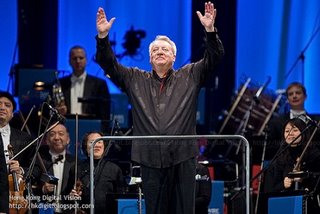Atherton, Hong Kong Philharmonic and Labèque Sisters Captivate Audience!
Review by Paul E. Robinson

 Next came Poulenc’s rarely-heard Concerto for Two Pianos. In his excellent notes, Marc Rochester rightly pointed out the Asian influences in the piece. Poulenc had heard some Balinese gamelan music in Paris in 1931, and the influence is clearly evident at the end of the first movement, and again in the finale. The concerto is typical of Poulenc in its combination of tunes that could have been borrowed from the popular music of the day, with episodes more chromatic and darker in feeling.
Next came Poulenc’s rarely-heard Concerto for Two Pianos. In his excellent notes, Marc Rochester rightly pointed out the Asian influences in the piece. Poulenc had heard some Balinese gamelan music in Paris in 1931, and the influence is clearly evident at the end of the first movement, and again in the finale. The concerto is typical of Poulenc in its combination of tunes that could have been borrowed from the popular music of the day, with episodes more chromatic and darker in feeling.
Classical Travels
THIS WEEK IN HONG KONG

This evening, we crossed the harbor from Hong Kong to Kowloon for a concert by the Hong Kong Philharmonic at the Hong Kong Cultural Centre. The orchestra’s conductor laureate, David Atherton, was on the podium and the Labèque Sisters (Katia and Marielle) were the featured pianists in works by Poulenc and Debussy.
Atherton began the evening’s all-French programme with Berlioz’ Corsair Overture. From the opening string flourishes, it was clear that we were listening to a fine orchestra under the direction of a demanding and forceful conductor. The HK Philharmonic played with exemplary precision and Atherton built the climaxes with a knowing hand.
 Next came Poulenc’s rarely-heard Concerto for Two Pianos. In his excellent notes, Marc Rochester rightly pointed out the Asian influences in the piece. Poulenc had heard some Balinese gamelan music in Paris in 1931, and the influence is clearly evident at the end of the first movement, and again in the finale. The concerto is typical of Poulenc in its combination of tunes that could have been borrowed from the popular music of the day, with episodes more chromatic and darker in feeling.
Next came Poulenc’s rarely-heard Concerto for Two Pianos. In his excellent notes, Marc Rochester rightly pointed out the Asian influences in the piece. Poulenc had heard some Balinese gamelan music in Paris in 1931, and the influence is clearly evident at the end of the first movement, and again in the finale. The concerto is typical of Poulenc in its combination of tunes that could have been borrowed from the popular music of the day, with episodes more chromatic and darker in feeling.The Labèque sisters played the piece with their usual flair and sensitivity to color. Atherton and the orchestra made the most of the unusual orchestration. After intermission, the soloists returned to play Debussy’s En blanc et noir, a work for two pianos without orchestra.
Debussy had been shocked by the outbreak of war the previous year and by the death of a close friend Jacques Charlot, an editor at the Durand publishing house, who was killed in battle. The second of the three movements in En blanc et noir was written in memory of Charlot. The performance was ideal.
Finally, Atherton and the HK Philharmonic presented Franck’s Symphony in D minor, in a truly a remarkable performance. This piece can be a tiresome experience; in the hands of most conductors it never seems to get going - the stops and starts seem endless.
With Atherton shaping the phrases and making sure that each was given time to breathe, the piece had a convincing inner logic. Nor was Atherton afraid to exhort the power of his brass, all the while superbly in control of the performance as a whole. His tempo for the slow movement was, to my mind, exactly right - just a shade slower than usual - and served to bring out the dolefulness of the music.
It’s difficult to generalize after only one concert, but I would venture to say that the quality of sound from the violin section can be attributed to the leadership of concertmaster John Harding. A vast range of bow strokes were used over the course of the concert, and the violins led by Harding covered a huge dynamic range, from the tenderest pp to the most powerful ff.
For the record, I was sitting in the stalls (ground floor, middle) about seven rows back from the stage. It seemed to me that the sound here was much better than in the balcony where I had sat for a concert earlier this month.
Under Edo de Waart (music director), and David Atherton (conductor laureate), the Hong Kong Philharmonic is in very good hands. The orchestra gives almost weekly subscription concerts, spends a lot of its time on educational programmes throughout the SAR (Special Administrative region…i.e., Hong Kong), and recently made a tour to several cities in China.
I was surprised to find that there were no recordings by the HK Philharmonic, Edo de Waart, David Atherton or any of the orchestra’s illustrious soloists available for sale at the HK Cultural Centre store. Surely this is a major marketing oversight that will soon be remedied!
Paul E. Robinson is the author of Herbert von Karajan: the Maestro as Superstar and Sir Georg Solti: his Life and Music, both available at http://www.amazon.com/.
Labels: classical travels, David Atherton, Hong Kong, Hong Kong Philharmonic, Lebeque Sisters



